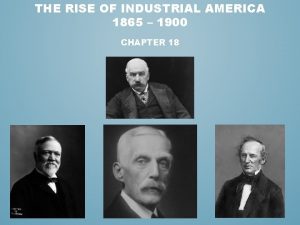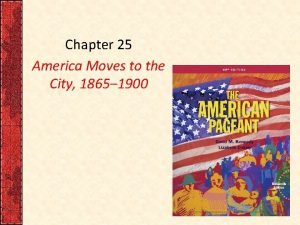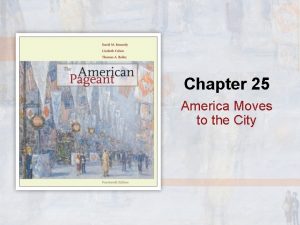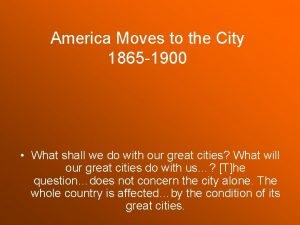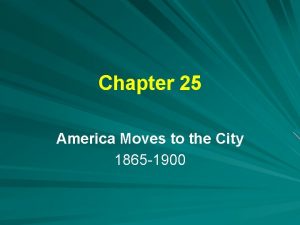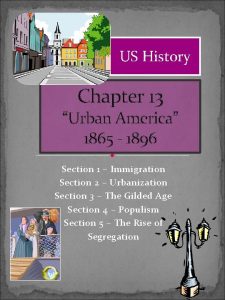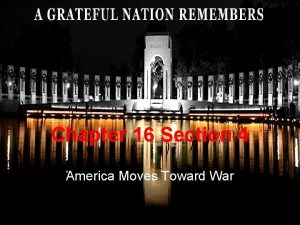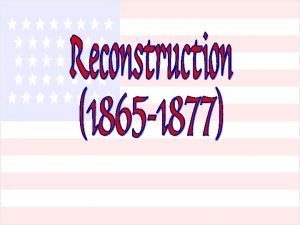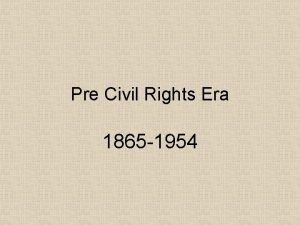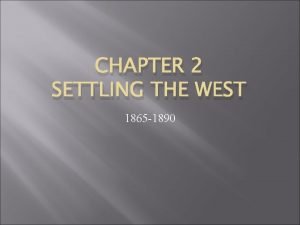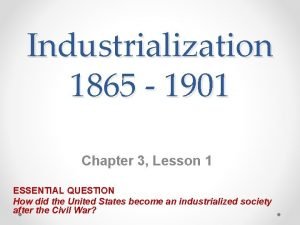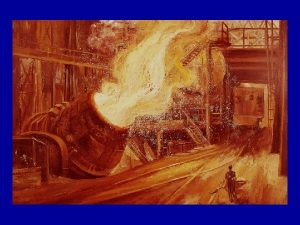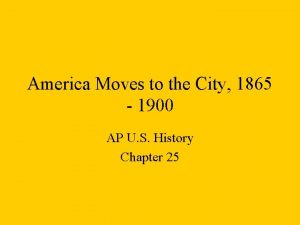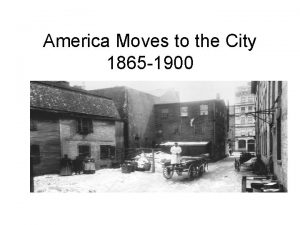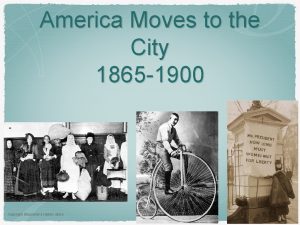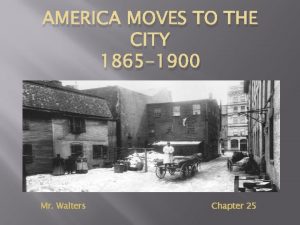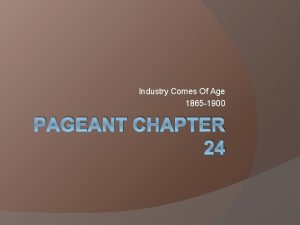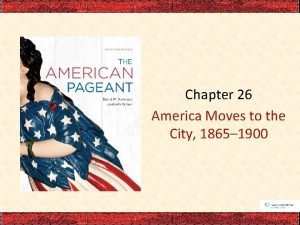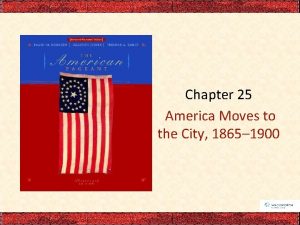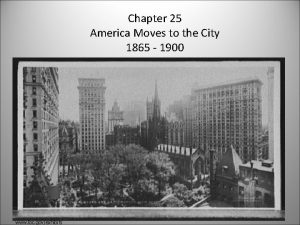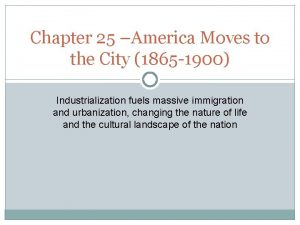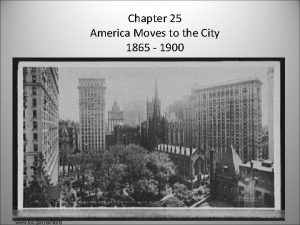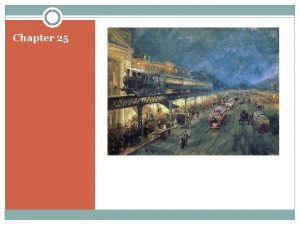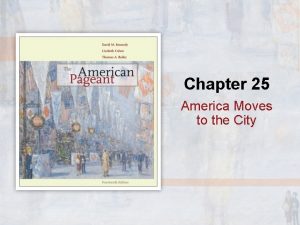America Moves To The City 1865 1900 PAGEANT























- Slides: 23

America Moves To The City 1865 -1900 PAGEANT CHAPTER 25

The United States - 1865

The United States - 1900

1. Urbanization 1865 -1900 This chapter will show us how the United States transitioned from a largely rural country to a highly industrialized, urbanized, diverse nation with growing cities – much like the U. S. we see today 1790 – 5% of Americans lived in cities 1900 – 39. 5% 1990 – 75. 2% What do we think of when we think of cities? Skycrapers; and to have skyscrapers we need elevators We can thank Louis Sullivan for the means to “move up” in cities Electric trolleys made it possible for people to commute within cities Indoor plumbing, the telephone, and shopping at department stores were the new things that brought people to cities and changed the daily lives of Americans at the turn of the century

New York

Chicago

Atlanta

1. Urbanization Living in cities in the late 1800 s and early 1900 s had its disadvantages though: No waste disposal, impure water, people didn’t bathe regularly, animal waste littered the roads, high crime rates

New York 1900 – before sanitation

2. The “New” Immigration A massive flux of immigrants poured into the United States after the Civil War between 1880 - 1920 The “new” immigration, however, came from a different part of the world Old immigration – most immigrants had come from the British isles and western Europe New immigration – came from southern and eastern Europe Unfortunately, new immigrants received no socioeconomic help from the United States gov’t during this time However, powerful city government officials, or “bosses” stepped into help…but not just out of the goodness of their hearts Taking care of new immigrants meant loyalty, votes, and support for city politicians Boss Tweed

William “Boss” Tweed

2. The “New” Immigration Religious leaders also got involved in taking on the new challenges that resulted from the new changes brought on by urbanization and immigration Some preached the “social gospel” – churches should tackle and try to solve the social problems of the day Walter Rauschenbusch – a pastor of a German Baptist church in NYC in 1886, advocated this Women also got involved Soft spoken but determined Jane Addams was deeply dedicated to uplifting the struggling urban masses The Hull House in Chicago was established by her; took in new immigrants, instructed them in English, and helped them transition to new life in America Other settlement houses would be established throughout the country The urban frontier opened up new possibilities for women

Jane Addams – Hull House

2. The “New” Immigration Many “Native” Americans began speaking out against the massive numbers of immigrants coming to the United States Though a lot of this was grounded in racism, some had valid concerns There were little restrictions against new immigrants at first: meaning criminals, the mentally disturbed, prostitutes, anarchists, and people carrying contagious diseases often slipped through easily… 1882 – Immigration restriction law was passed by Congress It was the first restriction law passed by the United States against immigration

Immigration In The U. S. 1820 - 1990

3. African-Americans React To “Jim Crow” Though the Civil War resulted in Amendments 13, 14, and 15, which granted African-Americans full equality, their struggle was not over against racism in the United States Southern states still passed discriminatory laws to limit African-Americans even after the Civil War / Reconstruction “Jim Crow” Laws – passed between 1876 and 1965 in the former Confederate states – set up “separate but equal” facilities Jim Crow was a black cartoon character that made fun of African Americans from the 1830 s There were some who rose up and advocated for black advancement and equality; two of the most notable were Booker T. Washington and W. E. B. Du. Bois

3. African-Americans React To “Jim Crow” Washington: Didn’t want to challenge Jim Crow, he wanted to gain white support through politics and let Jim Crow fade over time. Du. Bois: Condemned Washington’s view, set up the NAACP and demanded immediate full equality for blacks in American life.

Booker T. Washington & W. E. B. Du. Bois

4. Universities, Press, and Literature Just like when it gave land to RR corporations to build railways, the U. S. government also granted large amounts of land for the building of universities The Morrill Act of 1862 Philanthropists made their money privately but gave it to the public Andrew Carnegie poured money into expanding public libraries Journalism and newspapers expanded as well Sensational and embellished news stories became much more popular; newspapers began to compete and not just inform Journalist tycoons – Joseph Pulitzer and William Randolph Hearst

5. Moral Values and Women’s Rights All these new changes sparked a new debate about the role of women in American society. More and more women were calling for the right to vote – suffrage National American Women’s Suffrage Association founded in 1890

6. Reform, Art, and Culture During this time, people drank more alcohol than any other time in history Alcoholism caused many social problems in the U. S. Women such as Carrie Nation fought against excessive drinking, formed the Woman’s Christian Temperance Association in 1874 With a hatchet she stormed in bars and smashed bottles of liquor Art was flourishing in the meantime, amidst all these tumultuous problems One of the most notable American art forms created during this time was jazz music.

Carrie Nation

Jazz
 The rise of industrial america 1865-1900
The rise of industrial america 1865-1900 The rise of industrial america 1865-1900
The rise of industrial america 1865-1900 1865 to 1900 inventions
1865 to 1900 inventions America moves to the city
America moves to the city Chapter 25 america moves to the city
Chapter 25 america moves to the city America moves to the city chapter 25
America moves to the city chapter 25 America moves to the city
America moves to the city Chapter 25 america moves to the city
Chapter 25 america moves to the city Urban america 1865 to 1896
Urban america 1865 to 1896 Chapter 16 section 4 america moves toward war
Chapter 16 section 4 america moves toward war Chapter 24 section 4 america moves toward war
Chapter 24 section 4 america moves toward war America moves toward war section 4
America moves toward war section 4 How did the term impressionism originate
How did the term impressionism originate St helen’s smelting co v tipping (1865)
St helen’s smelting co v tipping (1865) Becoming a world power 1865-1917
Becoming a world power 1865-1917 Whats the compromise of 1877
Whats the compromise of 1877 1954-1865
1954-1865 Settling the west 1865-1890
Settling the west 1865-1890 Regionalism in american literature
Regionalism in american literature Becoming a world power 1865-1917
Becoming a world power 1865-1917 Industrialization 1865 to 1901
Industrialization 1865 to 1901 Gregor mendel 1865
Gregor mendel 1865 Industrialization (1865 to 1901 worksheet answers key)
Industrialization (1865 to 1901 worksheet answers key) Traits of impressionism
Traits of impressionism
